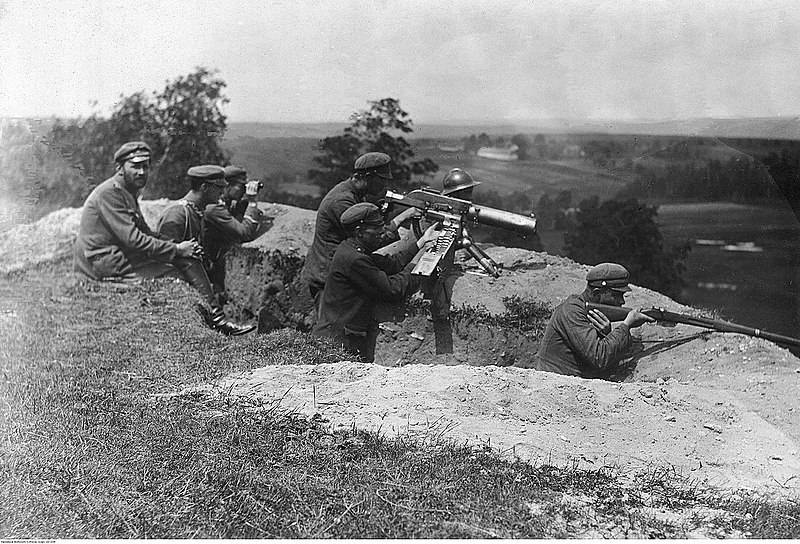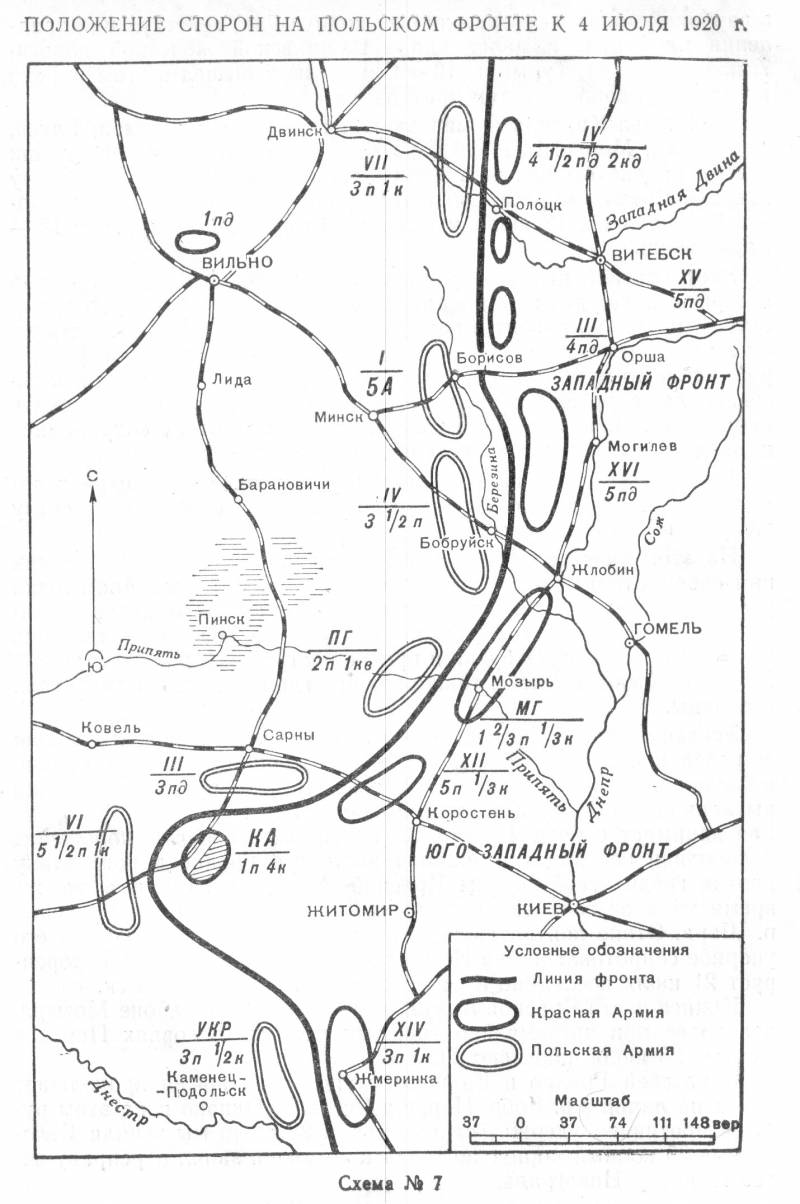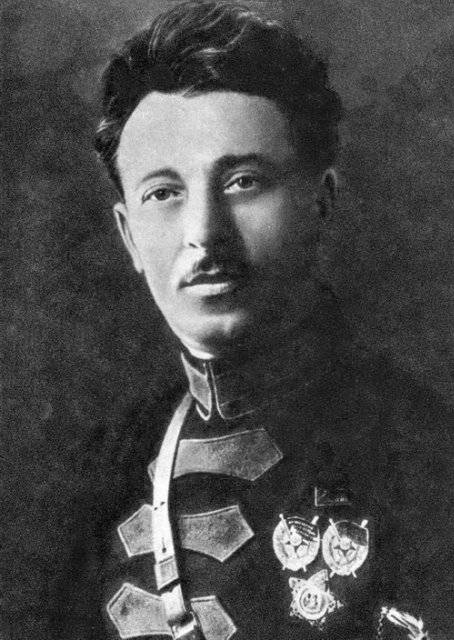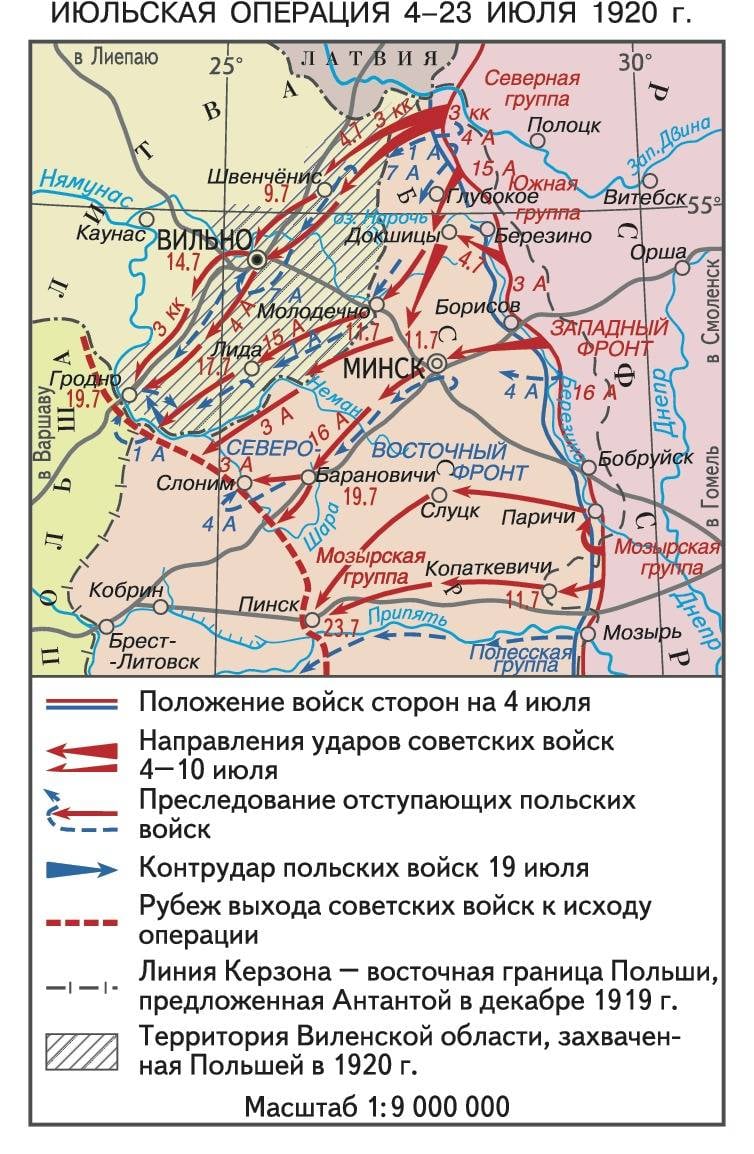Minsk is ours! The defeat of the Polish army in Belarus

Polish soldiers in position
100 years ago, the Red Army carried out the July operation. Soviet troops inflicted a heavy defeat on the Polish Northeast Front and liberated a significant part of Belarus and part of Lithuania, including Minsk and Vilna.
Offensive preparations in Belarus
At the same time as the offensive in Ukraine, the Red Army was preparing for an offensive operation in Belarus. The Western Front under the command of Tukhachevsky only in June 1920 received 58 thousand people as replenishment. During the preparation for the decisive offensive in White Russia, 8 rifle divisions, 4 rifle and 1 cavalry brigade were transferred here. The size of the front (including the rear units and institutions) increased from more than 270 thousand people in May 1920 to more than 340 thousand people in June and more than 440 thousand people in July. Also, the front was replenished with guns, small and cold weapons, ammunition, ammunition, etc.
The front in early July 1920 included the 4th (including the 3rd cavalry corps - the 10th and 15th cavalry divisions), the 15th, 3rd and 16th armies, the Mozyr group. There were about 120 thousand directly at the front (as the operation developed, up to 150 thousand people). A total of about 20 rifle and 2 cavalry divisions, over 720 guns and 2900 machine guns, 14 armored trains, 30 armored vehicles, 73 aircraft.
The troops of the Soviet 4th, 15th and 3rd armies (13 rifle and 2 cavalry divisions, a rifle brigade of about 105 thousand soldiers) were opposed by the 1st Polish army of General Zhigadlovich. The 1st Polish Army included 5 infantry divisions and 1 brigade, in total over 35 thousand bayonets and sabers. Against the red 16th army of Sollogub and the Mozyr group of Khvesin (over 47 thousand people), the 4th Polish army of General Sheptytsky and the Polesskaya group of General Sikorsky acted. In this direction, the Polish army had 6 infantry divisions and 1 brigade, in total over 37 thousand people. There was one division in the Polish reserve.
Thus, the Red Army had great superiority in forces. There were twice as many Soviet troops on the entire front, 3 times in the direction of the main attack. In the strip of the 16th Army and the Mozyr Group, the Reds had a slight advantage in strength. The Polish command planned to withdraw troops to a new line of defense: Baranavichy - Lida - Vilno. However, the commander of the Polish Northeast Front, Scheptitsky believed that it was impossible to surrender the existing front line without a fight. Therefore, the Poles were preparing to stop the Reds on the existing line. The capabilities of the Polish army in White Russia were weakened by the transfer of reserves and part of the forces at the front to Ukraine, where the offensive of the Soviet South-Western Front was successfully developed.
The Soviet offensive plan generally repeated the idea of the May operation (“The battle for Belarus. May operation of the Red Army ") Resting against the right wing in Lithuania, the Soviet strike group in the Vilnius direction was to defeat and encircle the 1st Polish army, then push the enemy troops to the marshy area of Polesie. Guy 3rd Cavalry Corps received the task of breaking through the rear of the enemy, in the direction of Sventsiany. The 16th army was advancing on Minsk. If the operation was successful, the Red Army inflicted a heavy defeat on the Polish army, liberated most of Belarus, and opened the way to Warsaw.

Source: S.S. Kamenev. The fight against white Poland. War Herald, 1922, No. 12, pp. 7-17. Notes on civil war and military construction. Military Publishing House, 1963
Breakthrough of enemy defenses and liberation of Minsk
July 4, 1920 the army of Tukhachevsky went on a decisive attack. As part of the 33rd Kuban Rifle Division of the 15th Army, Cork for the first time used three captured trophies repaired at the Putilov Factory tank Renault. The offensive developed successfully. On the very first day of the operation, Soviet troops advanced 15–20 km. In the battles of July 4–7, the northern flank of the Western Front crushed the 1st Polish Army. Polish troops suffered serious losses. The northern flank of the Polish front - the Dvina group, was defeated and retreated to Latvian territory, where the Poles were interned. Another group of the Polish army, the troops of General Zheligovsky (10th division), retreated to the line of the old German front, on the line Dvinsk - Lake Naroch - west of Molodechno - Baranovichi - Pinsk. The third group of the 1st Army was also defeated - the detachment of General Enzheevsky (the brigade of the 5th division and the reserve brigade). The Polish command, without serious reserves, on July 5 issued an order to withdraw troops in a general direction to Lida.
Thus, the Red Army on the fly broke the enemy’s defenses. However, as in May 1920, it was not possible to encircle the Polish army. This was due to errors of the front command. The right-flank group (3rd cavalry corps and the 4th Sergeev’s army), which was supposed to swiftly reach the Polish northern wing, turned out to be weaker than the front group, which delivered a frontal strike (15th army). The central group advanced faster than the right-wing group. This allowed the Poles not only to escape the environment, but also to break away from the Red Army.
The defeat and rapid retreat of the 1st Polish army sharply complicated the position of the 4th Polish army in the Minsk sector. The 16th Army of Sollogub was to force Berezina south-east of the city of Borisov. In the main direction, 3 divisions struck. The 27th Omsk Rifle Division (Putna commander) was the most powerful army division: 8 thousand bayonets and sabers, 34 guns and 260 machine guns. The fighters of the division had great combat experience - they fought on the Eastern Front with Kolchak.
On the night of July 7, 1920, the 16th Army attack group went on the offensive and crossed the Berezina in the morning. The Poles stubbornly fought back, but were forced to retreat. On July 9, our troops liberated the city of Igumen and reached the approaches to Minsk. In the east, the Poles created a strong defense, so parts of the 27th division bypassed the city from the north and south. July 11, the battle began in Minsk. By noon, units of the 27th and 17th divisions had broken the enemy’s resistance. Polish troops retreated west.

Commander of the 3rd Horse Corps Gaya Dmitrievich Gai
July 12, 1920 began the second phase of the operation of the Western Front. Again, the right wing was to play the main role. The right-flank group, hiding behind the border with Lithuania, was to create a threat to the northern wing of the Polish front and prevent the enemy from gaining a foothold in new positions. Meanwhile, the Polish command tried to gather additional forces and means in Belarus to stop the advance of the Red Army and stabilize the front. On July 9, Pilsudski ordered that the line of the old German front be retained by Vilna. Polish troops, having fixed themselves on the old line of the German front, where there were 2-3 rows of trenches, communication lines, concrete shelters and a large number of firing positions, were to stop, exhaust and bleed the Russians. Then, with the reinforcements approach, launch a counterattack and push the enemy back. In the region of Brest, an attack group was formed. That is, the Poles planned to repeat the scenario of the May battle.
However, the Polish army did not have time to gain a foothold in the new line of defense; there were not enough forces and means. We did not manage to form strike groups in time. This was largely due to the fact that in Ukraine the Polish front was also falling apart. In mid-July 1920, the Red Army broke through the enemy’s position. July 15 Pilsudsky order to withdraw troops to the line Pinsk - p. Neman - Grodno. To hold back the Russian offensive and cover up the withdrawal of the 1st Army, the 4th Polish Army was ordered to strike north on the flank of the advancing enemy strike group. But this plan also failed.
On July 14, Guy's cavalry and the 164th Infantry Division of the 4th Army liberated Vilna. The Lithuanian army opposed the Poles who occupied part of Lithuania. Polish troops from the Vilna region began to withdraw to Lida. The Soviet-Lithuanian negotiations in order to coordinate the actions of the two armies failed, which affected the pace of the offensive. As a result, it was agreed that the Soviet divisions would not violate the New Routes - Orany - Merech - Augustov line. On July 17, units of the 15th Army entered Lida; on July 19, the red cavalry unexpectedly burst into Grodno. A small Polish garrison fled. On July 19, units of the 16th Army liberated Baranavichy, July 21-22, the Soviet armies crossed the Neman and Shara. On July 23, the Mozyr group entered Pinsk.
Thus, the Soviet armies, due to the concentration of a powerful strike group and the weakening of the enemy in Belarus due to defeats in Ukraine, inflicted a heavy defeat on the Polish Northeast Front. The Red Army firmly seized the initiative in the war, liberated a significant part of White Russia and part of Lithuania. The conditions were created for the liberation of the remaining part of Belarus and the development of the offensive in the Warsaw direction. However, the Western Front could not surround and destroy the main enemy forces. This was caused by command errors, poor intelligence and the lack of large mobile reserves like the 1st Cavalry Army, which could go into the operational space, in the rear and complete the defeat of the enemy.

Map source: https://bigenc.ru/
Wrong choice
Quite quick and major success caused "dizziness from success" among the front command and the high command. The Soviet command overestimated the defeat of the enemy and decided on the move to strike at Warsaw, without pulling up and arranging the rear, strengthening the shock capabilities of the armies. Without concentrating the efforts of two fronts, the West and South-West, in Warsaw.
In the conditions of the collapse of the front in Ukraine, Warsaw established the Council of State Defense, headed by Pilsudski, with members of the government, parliament and military command. On July 5, the Defense Council turned to the Entente with a request for mediation in peace negotiations. During negotiations with representatives of the Entente on July 9-10, it was decided that the Polish army would withdraw to the so-called. Curzon’s line, the Poles will give up claims to Lithuanian lands and agree to hold a peace conference in London with the participation of Russia. Warsaw pledged to take a Western decision on Poland’s borders with Lithuania, Germany, Czechoslovakia and the future of Eastern Galicia. In the event the Bolsheviks renounced peace, Poland was promised military assistance. At the same time, the Poles hoped to use negotiations to restore and strengthen the army.
On July 11, 1920, a note from Lord Curzon was handed to Moscow with a request to stop the offensive at the Grodno-Nemirov-Brest-Dorogusk border east of Hrubieshov west of Rava Russkaya east of Przemysl. The Russians were supposed to stop 50 km east of this line. Finally, the border issues had to be resolved at a peace conference. If the Red Army continued its offensive, the Entente promised to support Poland "by all means." It was also proposed to conclude a truce with the Wrangel army in the Crimea. For reflection, Moscow was given 7 days.
On July 13-16, the Soviet leadership discussed this note. Opinions are divided. The head of the foreign department Chicherin took a cautious position. He proposed to accept the Entente’s proposal, to enter the Curzon line and, in this position, negotiate with Warsaw, tighten the rear, give troops time to rest and rebuild, and create a defense line. In case of failure of negotiations, resume the offensive. Counter conditions were set forth in Warsaw: negotiations with Moscow, reduction of the Polish army. Kamenev agreed to negotiations with Warsaw, but on the conditions of its demilitarization, he proposed to occupy Eastern Galicia. Trotsky believed that a truce with the Poles is possible. The command of the Western Front advocated the continuation of the offensive and the Sovietization of Poland. The most cautious position was expressed by Stalin, a member of the RVS of the Southwestern Front. He noted the successes of his front, but noted that it was too early to bury the Poles. Serious battles, bragging and complacency are still coming, shouts about the “March to Warsaw” are unacceptable.
The assessment of the situation by the military command at the front, set out in a note of July 15, was optimistic. The Soviet leadership at that time was dominated by the course on the "world revolution", which was promoted by Trotsky and his supporters. The soul was warmed by the rainbow hopes of red Warsaw, and then of Berlin. Therefore, the proposal of London was rejected. The Soviet leadership planned with one powerful blow to crush the entire Versailles system, which did not take into account the interests of Soviet Russia. On July 16, it was decided to continue the offensive and free the Polish workers from the yoke of the landowners and capitalists. However, the negotiations were not wholly rejected. On July 17, Moscow informed London that it was ready for negotiations with Warsaw without intermediaries. On the same day, the chairman of the Revolutionary Military Council of the Republic of Trotsky ordered the Western and South-Western fronts to develop an offensive. On July 20, England announced that in the event of a Russian offensive, it would cancel trade negotiations with Russia.
Thus, the military-political leadership of Soviet Russia overestimated the successes of the Red Army in the west and made a number of miscalculations. On July 19, a member of the PWS of the Western Front, Smilga, informed the Revolutionary Military Council of the republic that the left wing of the Polish army was completely defeated. On July 21, the commander-in-chief of the Red Army Kamenev urgently arrived in Minsk, at the headquarters of the Western Front. Having studied the optimistic reports of the front command, on July 22 he ordered the offensive to begin and by August 12 to occupy Warsaw. That is, the Polish army was considered completely defeated and incapable. Such an assessment was fundamentally erroneous. At the same time, the high command abandoned the original rational idea of a concentric offensive of two Soviet fronts on Warsaw. Now only Tukhachevsky was advancing on Warsaw. The army of Egorov was first to take the Lions. Kamenev and Tukhachevsky were convinced that the Western Front alone would be able to break through the enemy defenses on the Vistula and capture Warsaw.
- Alexander Samsonov
- https://ru.wikipedia.org/
- Smoot. 1920 year
Battle of Rostov
The disaster of white Odessa
How Slashchev Crimea defended
Dono-Manych battle
The death of the Northern Army Miller
Why Western agent Kolchak is turned into a hero and martyr of Russia
The defeat of the army of Denikin in the battle of Tikhorets
How did the Ice Siberian campaign end
The fall of the White Kuban
Agony of White Novorossiysk
The death of the Kuban army
Denikin's resignation
Far Eastern Republic and the Japanese threat
Polish "liberation" campaign in Kiev
Baku “Blitzkrieg” of the Red Army
The battle for Belarus. May operation of the Red Army
War of the Russian Army Wrangel
The first victories of the Wrangel army
The defeat of the 13th Soviet Army in Northern Tavria
Our Kiev!
The battle for Rivne. How Budyonnovtsy smashed the Polish defense
Information